Are you confused by "100% waterproof" claims for flooring? Many buyers struggle to understand what this really means. Let’s clear up the confusion about SPC and LVP.
When people say "100% waterproof" for SPC and LVP flooring, it means the plank itself will not swell, buckle, or lose integrity when exposed to water. This is because their core materials (stone plastic composite or virgin vinyl) are inherently non-porous and do not absorb water.
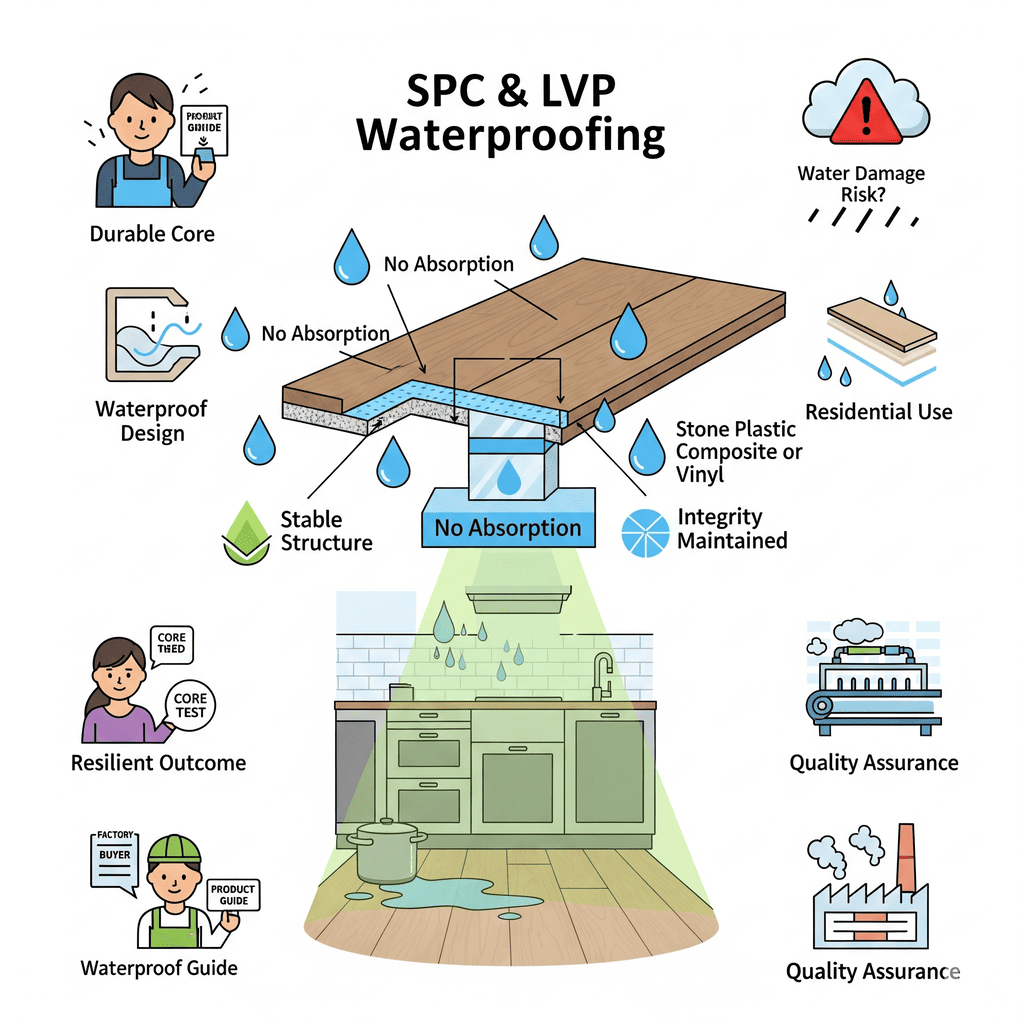
As a factory owner, I often hear questions about waterproof flooring. Buyers like Aiden and Louis, who focus on quality and competitive prices, need clear answers. Let’s dig deeper into these important points.
How can retailers accurately market the "100% Waterproof" feature for SPC and LVP?
Retailers often struggle to explain "100% waterproof" clearly. Are you sure your sales team is telling the right story? Misleading claims can hurt your brand.
Retailers must stress that "100% waterproof" means the plank itself resists water. It will not swell or warp from spills. This feature applies to the core material, not the entire installed floor. Always highlight the material’s inherent water resistance.
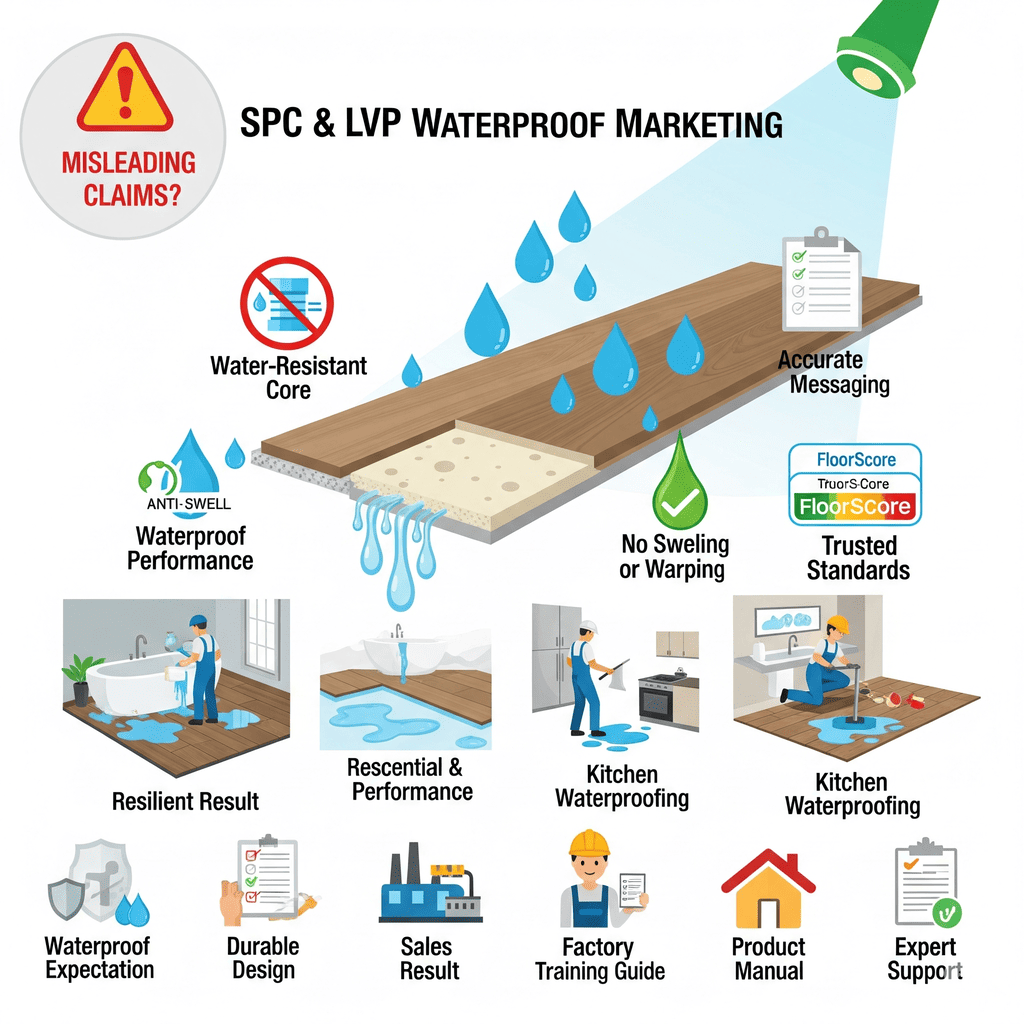
When I talk to buyers, I see the need for clear marketing. For SPC and LVP, the core is the key. SPC has a rigid, stone-plastic composite core. LVP has a solid, virgin vinyl core. Both of these materials do not absorb water. So, if you spill a drink, the plank itself is safe. This means the material will not get damaged by water.
Research suggests SPC and LVP flooring can be marketed as "100% Waterproof1" if tested for water resistance2. Retailers can accurately market these floors by highlighting their ability to withstand water exposure, even submersion, without damage. We emphasize our testing standards and our product’s suitability for wet areas like bathrooms.
For example, SPC flooring with its stone-plastic core is great for kitchens and basements. Certifications like FloorScore also build trust with my clients. I always advise our clients to train their sales teams to communicate clearly about the flooring’s composition.
They should mention the extended warranties too. These are often up to 25 years or lifetime for residential use. This sets clear expectations and protects the customer’s investment. It is important to avoid overgeneralizing, as not all LVP products match SPC’s level of waterproofing.
| Marketing Strategy | What to Say | What to Avoid |
|---|---|---|
| Focus on Core | "The plank’s core is waterproof." | "Your entire house will be waterproof." |
| Benefits | "Great for spills and high moisture." | "Prevents all water damage." |
| Material | "Made from non-porous SPC/LVP." | "Seals your subfloor." |
| Examples | "Ideal for kitchens and bathrooms." | "Flood-proof." |
| Clarity | "The plank itself won’t swell." | "No water will ever get underneath." |
How should sales teams clearly articulate the difference between "Waterproof" and "Water Resistant" flooring?
Do your sales teams mix up "waterproof" and "water resistant"? This confusion can lead to unhappy customers. It is important to know the real difference.
Sales teams must explain that "waterproof" flooring, like SPC/LVP, has a core that water cannot penetrate. It will not swell. "Water resistant" flooring, like some laminates, only slows down water absorption. It can still get damaged if water stays on it too long.
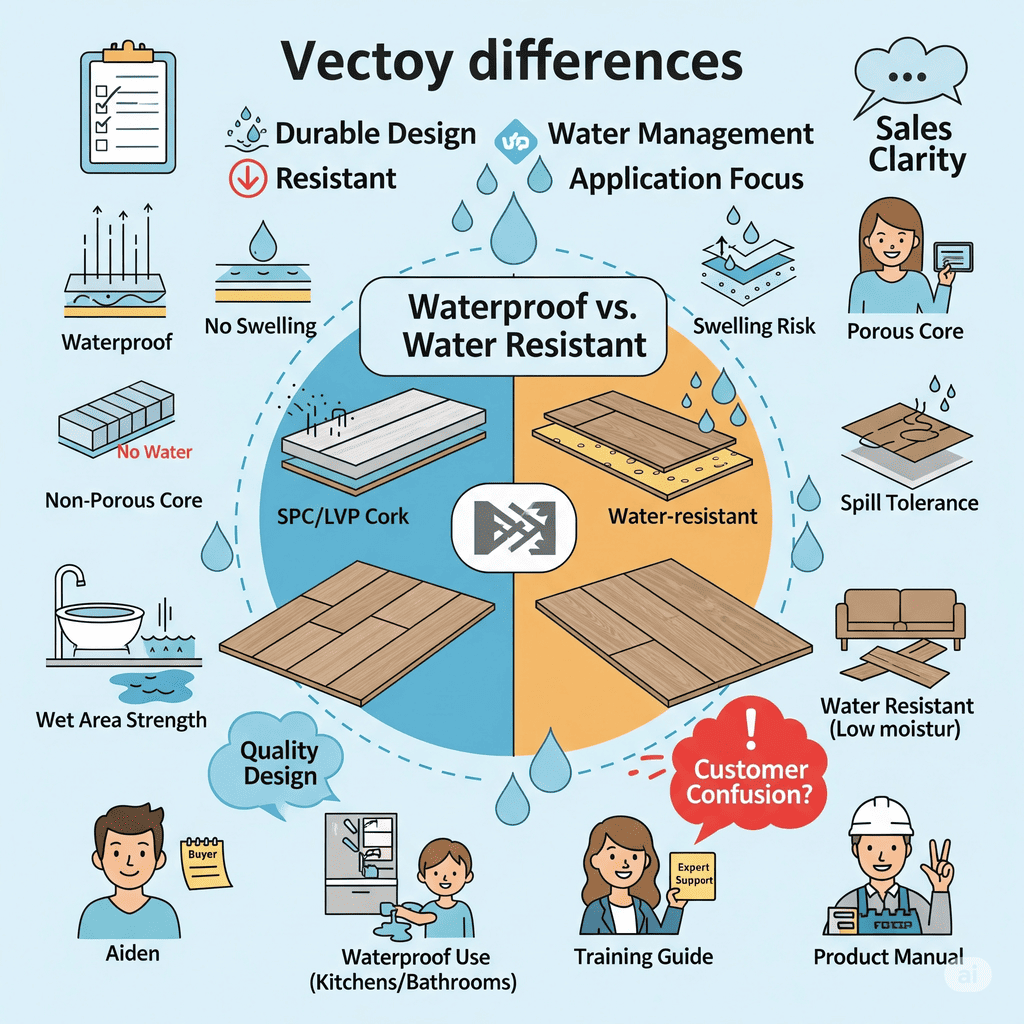
Aiden, our buyer from the UK, always asks about quality. He needs to know the exact difference. I tell him "waterproof" means the core material is impervious to water. For SPC and LVP, this is true. Their cores are made of materials that do not absorb water.
"Waterproof" flooring is designed to handle standing water and even flooding without damage. This makes it ideal for high-moisture areas like bathrooms and kitchens. It seems likely that "Waterproof" flooring handles standing water, while "Water Resistant" manages spills. My sales teams clearly articulate this.
We explain that "Water Resistant" flooring can manage occasional spills. But it is not designed for prolonged water contact. If water sits on it for too long, it can swell or buckle.
For example, water-resistant laminate might be fine for a living room. But it is not good for a bathroom where water splashes often. This distinction is crucial for my customers, especially those dealing with homes with pets or children. Sales teams also highlight the warranty differences1, showing the added protection of waterproof floors.
| Feature | Waterproof Flooring (SPC/LVP) | Water Resistant Flooring (Some Laminates/WPC) |
|---|---|---|
| Core Material | Stone Composite / Virgin Vinyl (Non-porous) | Wood-based / Fiberboard (Can absorb water) |
| Water Effect | Will not swell or warp from water contact | May swell or warp if water sits for long |
| Durability | Very high resistance to water damage | Moderate resistance, depends on exposure |
| Best Use | Kitchens, bathrooms, basements, high spills | Living rooms, bedrooms, low moisture areas |
| Long-term | Better performance in wet conditions | Requires quick clean-up of spills |
What role do locking system design and proper installation play in achieving a "100% Waterproof" floor?
You might think the plank is all that matters for "waterproof" floors. But is it? The locking system and how you install it are also very important.
While the SPC or LVP plank core is waterproof, the locking system helps prevent water from seeping between planks to the subfloor. A tight, well-designed click lock reduces gaps. Proper installation, including a level subfloor and expansion gaps, is crucial for overall floor integrity against moisture.
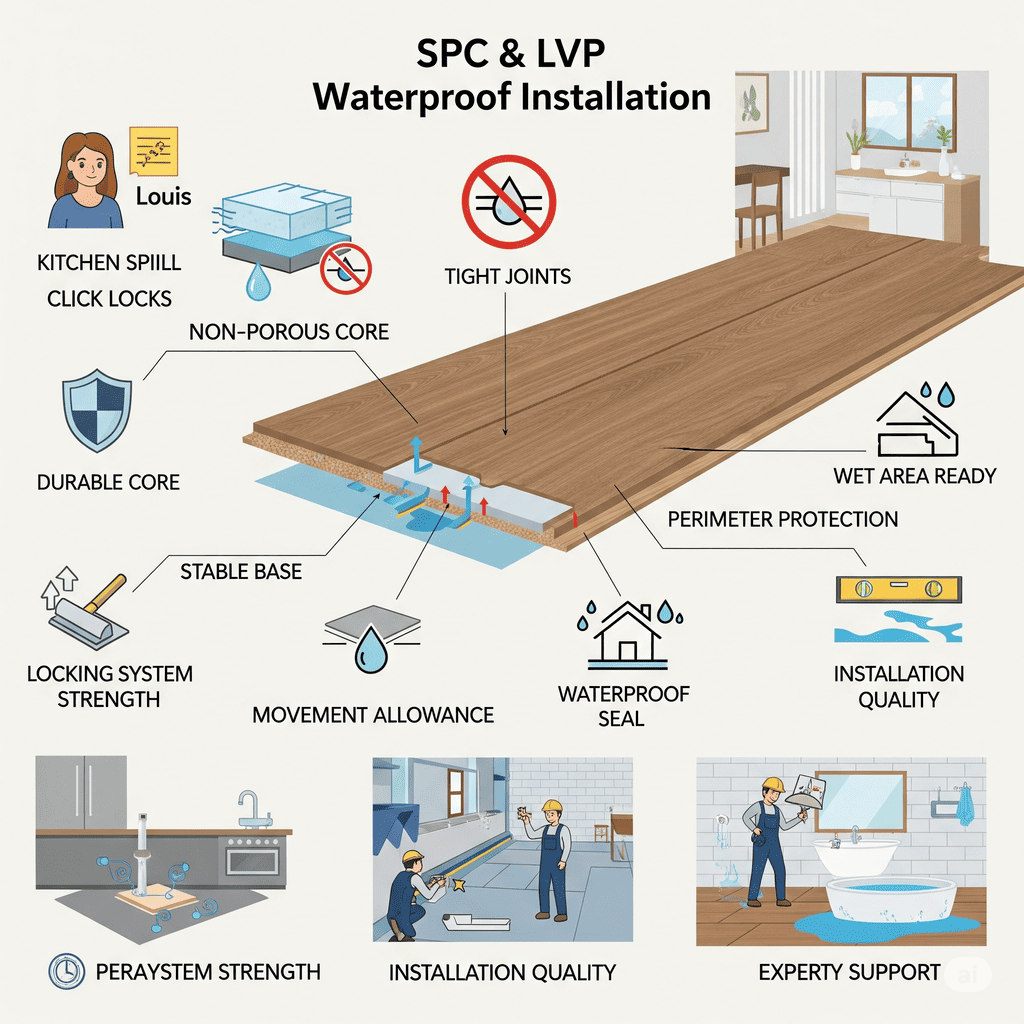
Louis from the US, our COO client, always cares about product performance. She knows that even the best product needs good installation. My factory uses advanced click lock systems for our SPC and LVT. These systems, like Uniclic® or 5G installation, create a tight seal between planks.
This tight fit makes it harder for water to get through the joints to the subfloor. The evidence leans toward locking systems and installation being vital for waterproofing, not just the plank material. Planks must be clicked together securely to avoid any gaps.
Research shows that improper fitting can compromise the waterproofing. This can lead to subfloor damage. This is why proper installation is key. The subfloor must be clean, dry, and level.
Installers need to leave expansion gaps around the room’s edges. This allows the floor to move slightly with temperature changes. Edges, perimeters, and transitions must also be sealed using manufacturer-recommended sealants. If installation is not done right, it can void warranties. This underscores the importance of professional installation or following our instructions carefully.
| Installation Factor | Importance for Water Protection | Details |
|---|---|---|
| Subfloor Prep | Crucial for overall performance | Must be level, dry, clean, and sound |
| Click Lock System | Minimizes water seepage between planks | Ensures planks fit tightly without gaps |
| Expansion Gaps | Prevents buckling from temperature changes | Allows floor to expand/contract naturally |
| Edge Sealing | Can add a layer of protection at perimeter | Usually done with trim or silicone seal |
| Room Environment | Controls humidity and temperature | Important for long-term stability |
How do warranties differ between "Waterproof" and "Water Resistant" flooring products?
Are you confused about what your flooring warranty covers? Many buyers do not know how "waterproof" and "water resistant" impact their warranty. It is important to know.
"Waterproof" flooring warranties often cover material damage from topical moisture exposure, like spills, for the lifespan of the product. "Water resistant" warranties have stricter limits, usually excluding standing water damage. Always read the fine print; floods and subfloor damage are rarely covered by either.
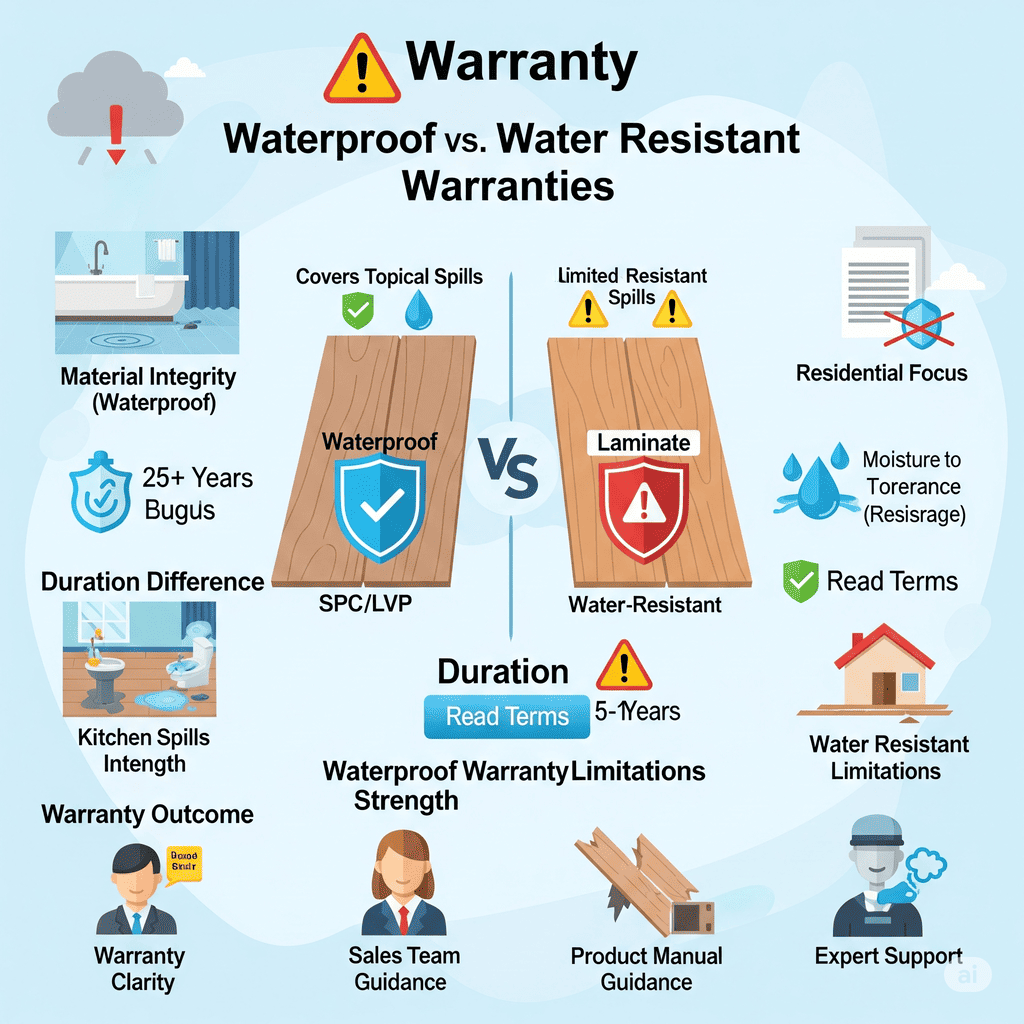
When I work with big company buyers, I always discuss warranties. A true "waterproof" SPC or LVP warranty usually states that the plank itself will not swell or be damaged by topical water. These warranties are typically longer.
For residential use, they are often 25 years or even lifetime. For commercial projects, they can be 10-15 years. These warranties cover defects in materials and workmanship. They also protect against wear-through, staining, and water damage. This is provided that installation and maintenance guidelines are followed. For example, some brands like L.W. Mountain offer lifetime limited waterproof warranties for SPC/WPC vinyl floors.
However, it is very important to understand what is not covered. No flooring warranty, even for "waterproof" products, covers damage from major floods, broken pipes, or water coming from under the floor. These are usually seen as external disasters.
"Water resistant" warranties are much more limited. They are usually shorter, perhaps 5-10 years. They may also exclude water damage completely. This is because these products are not designed for long water exposure. My factory provides clear warranty details for our LVT and SPC products. We make sure our North American and UK clients understand these terms. It is about setting realistic expectations and protecting your investment.
| Warranty Type | "Waterproof" Flooring (SPC/LVP) | "Water Resistant" Flooring |
|---|---|---|
| Material Damage | Covers swelling, buckling from surface spills | Limited coverage, often excludes standing water |
| Duration | Often lifetime residential, long commercial | Shorter terms, sometimes 10-25 years residential |
| Exclusions | Floods, subfloor water, improper installation | Any prolonged water exposure, floods, subfloor water |
| Claims | Focus on plank integrity post-water contact | Requires proof of quick clean-up of spills |
| Protection Level | Higher confidence against daily moisture | Lower confidence, requires immediate action |
Is achieving a "100% Waterproof" floor solely dependent on the plank material, or also on edge sealing?
Is a "100% waterproof" floor just about the plank? Or does edge sealing1 play a role? This is a common question. Let’s look at the full picture.
Achieving a "100% waterproof" floor depends mainly on the plank’s core material for SPC and LVP. Their non-porous cores resist water. Edge sealing, like silicone at the perimeter, helps prevent water from reaching the subfloor at walls or fixtures. It enhances the overall system’s water protection, but the plank is the primary waterproof element.
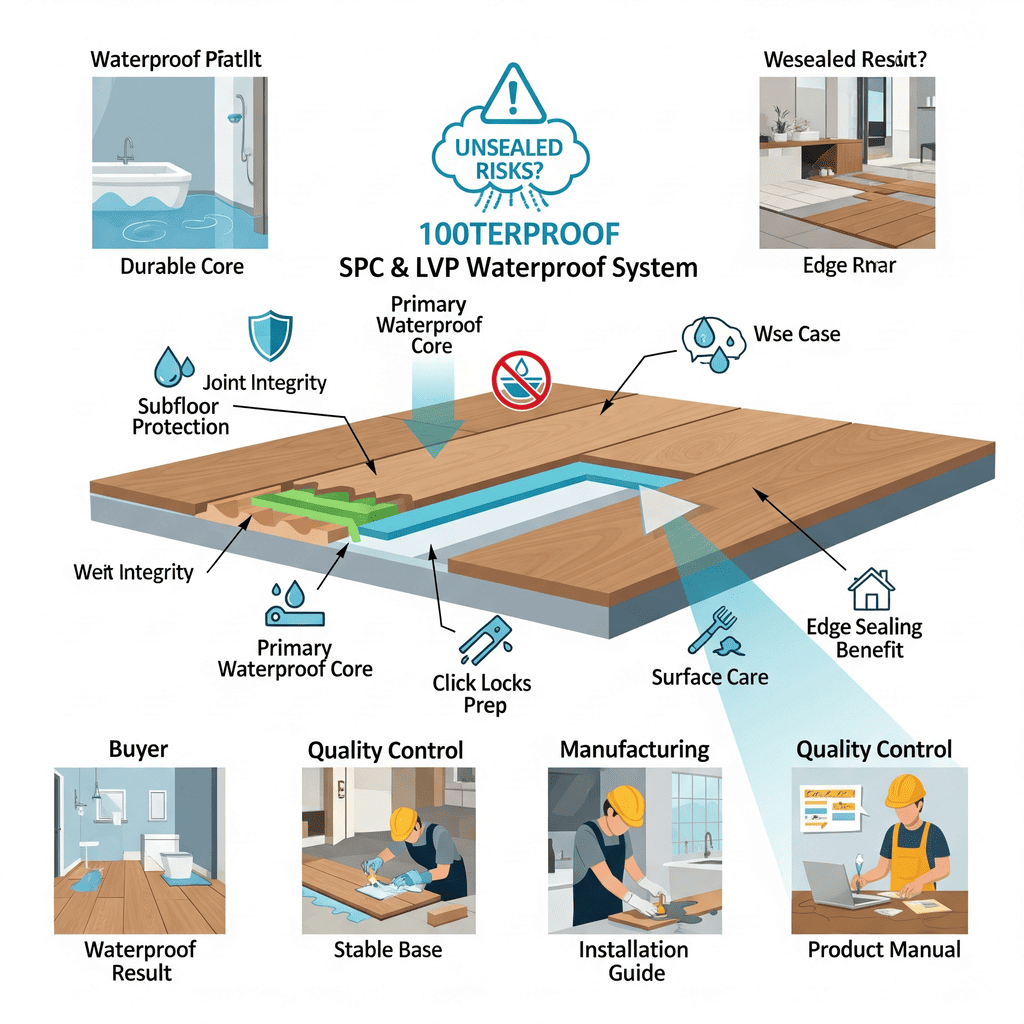
I often get asked if edge sealing is needed for our LVT and SPC. For our products, the core material is the main hero. SPC and LVP planks are inherently waterproof due to their composition.
For example, SPC’s stone-plastic composite core resists water, dents, and temperature changes. This means if a plank sits in water, it will not get damaged. It will not swell or warp. This is the core of being "100% waterproof."
However, even waterproof planks can fail if water enters through joints or perimeters. This is where edge sealing becomes a critical component. Edge sealing is typically done at the perimeter of the room using a sealant like silicone or specific tapes.
This prevents water from running off the floor surface and going under the floor at these edges. This helps protect the subfloor in case of spills near the walls or fixtures. It does not make the plank itself more waterproof. The plank already is. Instead, it adds another layer of protection for the subfloor. Installation guidelines often stress the importance of a level, dry subfloor and proper sealing to maintain waterproof integrity. Water can penetrate through unsealed edges, potentially damaging the subfloor or causing delamination.
| Factor | Contribution to Water Protection | Why it matters |
|---|---|---|
| Plank Core Material | Primary waterproof element | SPC/LVP cores are non-porous and do not absorb water, preventing plank damage |
| Click Locking System | Prevents surface water from seeping between planks | Creates a tight seal, reducing gaps for water entry |
| Perimeter Edge Sealing | Protects subfloor at walls and fixtures | Stops water from running under the floor at room edges |
| Subfloor Condition | Essential for overall floor stability and health | A dry, level subfloor prevents moisture issues from below |
| Maintenance | Keeps surface free from standing water | Regular cleaning and immediate spill clean-up adds to longevity |
How can distributors justify price differences between "Waterproof" and "Water Resistant" features?
Are your customers asking why "waterproof" flooring costs more? It can be hard to explain price differences clearly. Let’s break down the value.
Distributors can justify higher "waterproof" flooring prices by highlighting superior core materials (SPC/LVP), advanced manufacturing processes, and long-term durability. "Waterproof" offers greater protection against moisture, reducing future costs from water damage and providing peace of mind. It is a long-term investment in floor integrity.
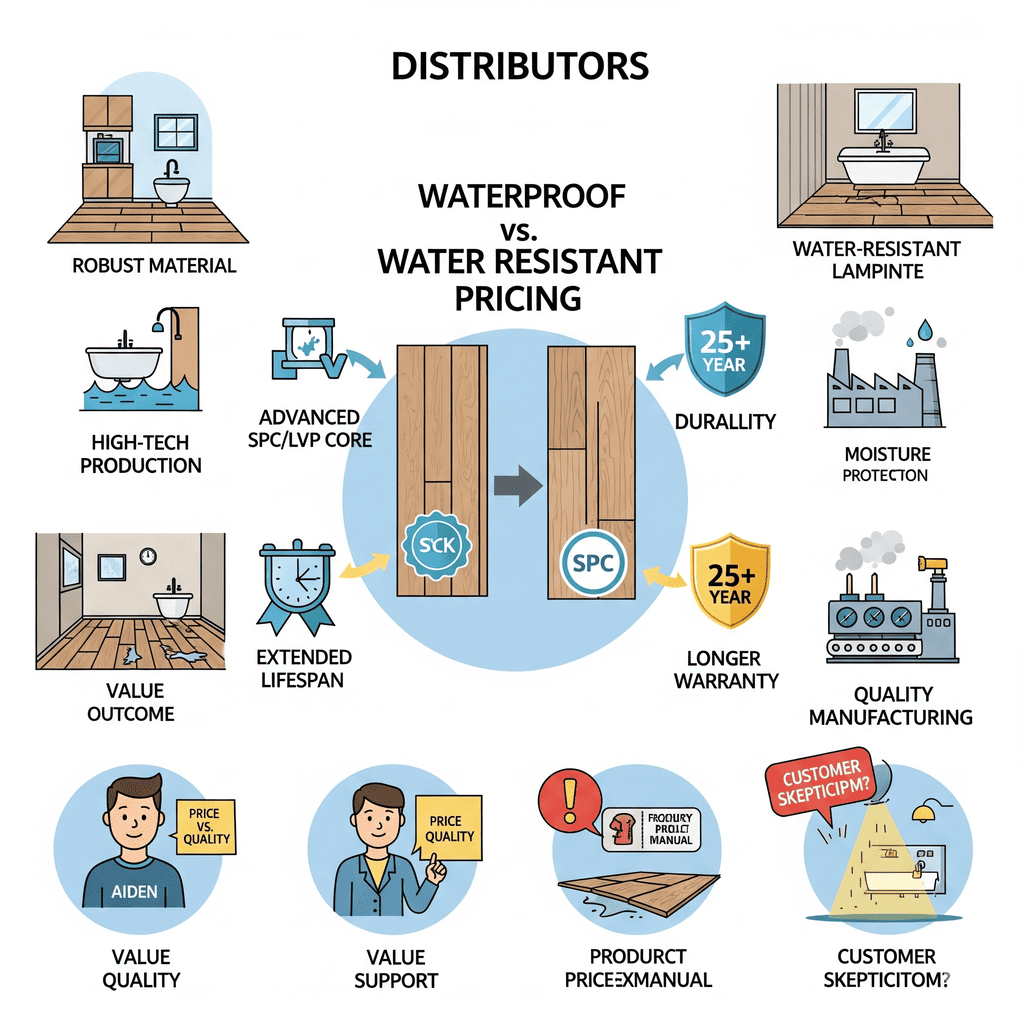
Aiden, our UK client, is sensitive to price but values quality. Louis, in the US, also seeks competitive prices. I explain to them that the price difference in "waterproof" flooring, like our SPC and LVT, comes from the material and the manufacturing process.
"Waterproof" flooring, such as SPC, uses advanced materials like stone-plastic composites. These are more durable and resistant to water, dents, and temperature swings. This makes them more expensive to produce. "Water resistant" flooring, often made with less robust materials, is cheaper. However, it is also less capable of handling moisture.
The higher price for waterproof flooring2 brings significant value. It offers excellent performance and durability. It has a lifespan of 20-30 years in high-moisture areas. Water-resistant flooring has a shorter durability in wet conditions.
The warranty coverage also justifies the higher cost. Waterproof flooring offers longer warranties, sometimes 25 years or lifetime residential. This added protection reduces the risk of costly repairs. It also offers peace of mind. My clients get a floor that resists spills, pet accidents, and high humidity without damage. This means fewer replacements, fewer warranty claims, and a longer lifespan. For a distributor, this translates to happier customers and fewer headaches. It is an investment in durability and peace of mind.
| Feature | Waterproof Flooring (e.g., SPC, LVP) | Water Resistant Flooring |
|---|---|---|
| Water Handling | Handles standing water, submersion, and flooding | Handles occasional spills, not prolonged exposure |
| Suitable Areas | Bathrooms, kitchens, basements | Living rooms, bedrooms, low-moisture areas |
| Material Quality | High (e.g., stone-plastic composite core) | Lower (e.g., vinyl or laminate with limited resistance) |
| Warranty Duration | 25 years or lifetime (residential), 10-15 years (commercial) | 5-10 years, may exclude water damage |
| Price Range | Higher (e.g., $5.40-$5.90/sq ft for premium brands) | Lower, varies by brand and quality |
| Installation Needs | Requires edge sealing, proper locking system installation | Less critical, but still needs prompt spill cleanup |
Conclusion
Understanding "100% waterproof" for SPC and LVP is vital. It means the plank resists water, not the whole floor. Proper marketing, clear distinctions, good installation, and understanding warranties are key.
The above data is for reference only.
